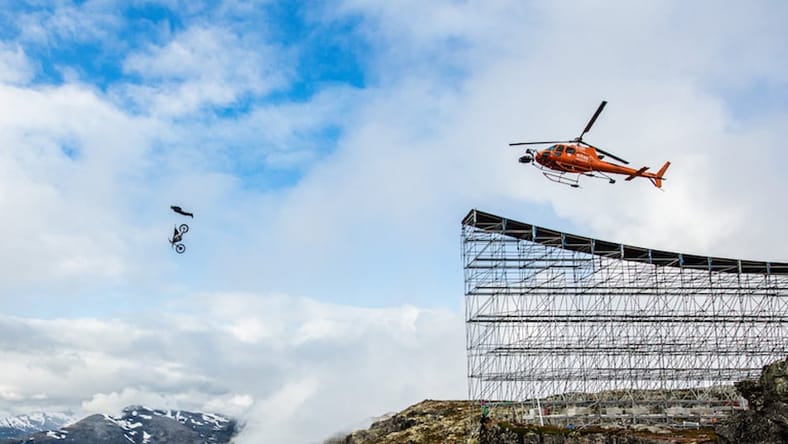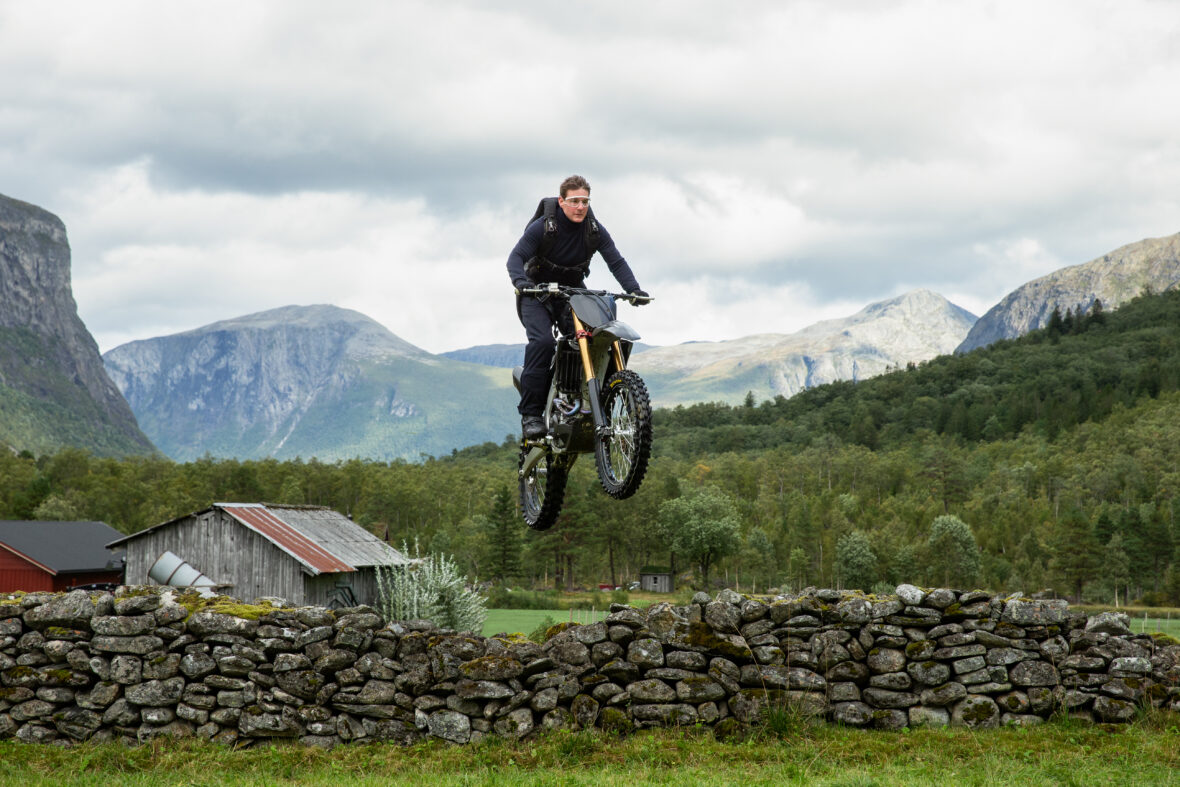
“Honestly, the motorcycle jump off the cliff in Norway wasn’t the most difficult sequence to film. I know that sounds ridiculous!” says Fraser Taggart, the cinematographer of Mission Impossible – Dead Reckoning — Part One.
Taggart worked on the film five years after serving as the 2nd unit cinematographer on the vertiginous helicopter chase and the HALO jump sequences in 2018’s Fallout, so he knows stunts.
This week, actor-producer Tom Cruise and writer-director Christopher McQuarrie are back with the seventh installment in the Mission Impossible franchise, which has grossed $3.5 billion over 27 years — outlasting four American presidencies and two James Bonds.
With a long list of studio actioners on his C.V. – including Kingsman: The Secret Service and John Wick: Chapter 2 – the U.K.-based cinematographer first collaborated with Cruise and McQuarrie on 2012’s underrated sci-fi, Edge of Tomorrow – “definitely one of my favorite films that I’ve ever worked on,” Taggart says.
Also Read: Tom Cruise and Mission Impossible Director Christopher McQuarrie Argue a Lot — About You
“And then they asked me to work on bits of MI5, which again, worked very well.”
An avid fan of European and Scandinavian cinema, Taggart wanted to bring his own flavor to the film while still keeping the classic visual essence of the Mission Impossible franchise.
“I love it where you’re not appealing to the trendiest methods of the time. I remember in the 2000s, everyone was into muted light and everyone was doing the same thing,” he says. “In some franchises, you can get too locked into the genre and I wanted to try and break away from that, bringing different looks to the story. So, McQ and I agreed to push the boundaries a bit.”
That’s a tall order considering the prior Mission Impossible films have already seen Cruise scaling the 2,700-feet Burj Khalifa in 2011’s Ghost Protocol, hanging on the outside of an Airbus A400M cargo plane mid-takeoff with just his bare hands in Rogue Nation, and piloting his own chopper in the nail-biting helicopter chase in Fallout.
That last outing also famously features Henry Cavill’s turncoat, August Walker, “reloading his biceps” during the bone-crunching bathroom brawl, a micro-stunt that delighted Cruise to no end (you can see him calling it out during various press junkets).

This time around, Ethan Hunt (Cruise) is up against an uncannily timely enemy that captures the AI-anxiety zeitgeist of the moment. Controlled only by a two-part cruciform key, an all-powerful AI gone rogue dubbed “The Entity” has the power to redefine reality as we know it.
Ethan’s task – should he choose to accept it – is to intercept the key before anyone else. Aside from tapping into the current AI-fearing zeitgeist, the film reminds us that ‘analog’ approaches may yet prove useful in the digital age. At one point, CIA workers scramble to duplicate digital data on hard copies (with typewriters!) in a mad dash to salvage intelligence data. Just as Pete Mitchell proved that (human) fighter pilots are still needed in the age of remote-flying drones in Top Gun: Maverick, a running theme in recent Cruise films seeks to convince us that there is still room for analog-era methods in today’s digital world.
Largely due to the intense stunts involved, Dead Reckoning is the first Mission Impossible film to be shot entirely on digital, utilizing the Sony Venice. “I love the Venice sensor – it’s soft and more forgiving. It’s more filmic to me.”
Since the Mission brand is known for its practical effects, all that action had to be captured in-camera.
“I love shooting on film – the past MI movies were shot on anamorphic 35mm. But for everything we wanted to shoot here, like the fight on top of the moving train, the guys had to be able to operate the cameras on the train,” Taggert says, referring to The Entity’s human proxy, Gabriel (Esai Morales), and Ethan’s mano a mano atop a runaway train hurtling down the track at 60 mph.
A special effects locomotive was built to film it all in-camera, which was shot on 40 kilometers of track running through the countryside of Andalsnes, Norway.
Using digital cameras generally allows filming for 40 minutes at a time, as opposed to reloading film magazines every 10 minutes. “If we had gone with film, we’d have to stop the train every few minutes,” Taggart adds.
“We used digital on the helicopter sequence and the HALO jump in Fallout too, since we couldn’t mount six film cameras on the helicopters. The weight of the film stock and time constraints would have been so restrictive.”
With production taking place entirely during the COVID-19 pandemic, using digital cameras also helped minimize contact amongst the camera crew, since fewer magazine swaps were required.
However, since Mission films have a classic, softer and gentler look of emulsion, Taggart’s team went with older lenses to mitigate the clinically crisp look of digital. “Most of the modern lenses are too crisp and loses that filmic contrast – the cleaner, crisper images don’t work for this project. So, we used older glass to soften up the digital image, with lenses from the 1960s, the Panavision C-series. We shot anamorphic because it’s more forgiving, it’s a fantastic format,” Taggart explains.
After testing some 30 miniature cameras trying to match the sensor to the Sony Venice, Taggart ended up with the Zed camera. “The company was extremely helpful in redesigning small and versatile cameras that we needed for these sequences,” he shares.
“We could detach the main camera sensor and the lens from the body,” which was the only way they could shoot the adrenaline-inducing car chase through Rome in the teeniest Fiat 500 – with Ethan steering with only one hand because he and Grace were handcuffed to each other.
All About the Mission Impossible Motorcycle Parachute Scene
Now, let’s get to the most talked-about sequence on this Mission Impossible film — the motorcycle jump, which Paramount began touting in the first teaser that accompanied Top Gun: Maverick’s theatrical screenings last year.
The equilibrium-shattering stunt features Cruise jumping off a near-vertical cliff in Norway’s Helsetkopen mountain — some 3,900 feet above sea level — on a Honda motorbike, and then descending a stomach-churning 4,000 feet in a BASE jump. He did it not once, but eight times to make sure the crew got all the footage they needed.
“Since the Zed-cam has a cord that attaches the lens to the main body, we could strap it onto Tom’s back and put the lens where we needed it. That is how we were able to do all the skydiving sequences,” Taggart pointed out.
In addition, they also covered the sequence from land, drone units, and aerial units in helicopters so that “we could show that it was really Tom Cruise jumping off a 4,000-foot cliff face on a motorbike.”
So What Was the Hardest Scene to Shoot in Mission Impossible — Dead Reckoning?
“Oddly enough, that wasn’t the toughest sequence for me. As the DP, my most worrisome sequences were everything we shot in Venice,” Taggart reveals.
Rather than staging the action on the canals, McQuarrie wanted to show more of the city’s gothic architecture to highlight the somber vibe and labyrinthine layout. The darker visual pallet turned out to be the most daunting for Taggart during the entire production.
“Venice has no light unless you’re walking on the pavement outside tons of restaurants. And most of the locations we picked were tiny little shoot-off canals and tiny alleyways away from anything. So, we were literally knocking on doors asking residents for permission to put a light on their balcony or roof terrace,” Taggart recalls of the challenging conditions, including when they were shooting the moonlit duel on the Venetian bridge between former MI6 agent and Ethan’s love interest, Ilsa (Rebecca Ferguson), and Gabriel.
Things got worse when COVID-19 brought Mission Impossible to a jarring halt in March 2020, when they had to be evacuated the day before they were due to start filming in the city.
In one of the most ferocious clashes set in Venice (filmed on a soundstage in London’s Longcross Studios), Ethan and Paris – Gabriel’s brutal French assassin – bash, stab, punch, and pummel each other in an insanely narrow vicoletto, one that is quite literally shoulder-width.
“As a DP, the most impractical sets are the most interesting in many ways, because it forces you to come up with an interesting plan when you’re confronted with something bloody difficult. But I sort of love those challenges,” Taggart says, sharing the joy that has fueled his four-decade career.
Mission Impossible – Dead Reckoning, Part One is now in theaters.
Main image: Tom Cruise on the set of Mission Impossible — Dead Reckoning Part One from Paramount Pictures and Skydance.
